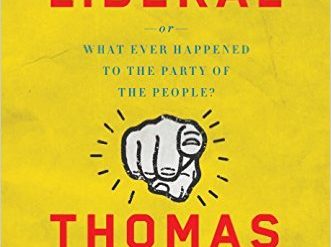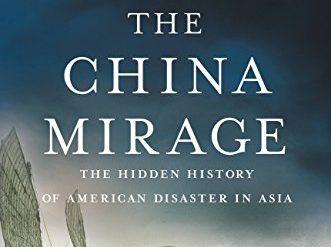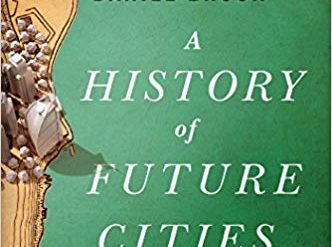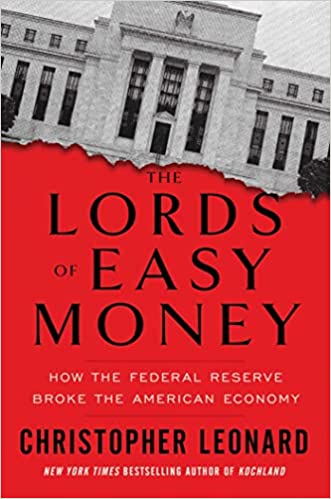
When I first became aware of the stock market in 1960, the Dow Jones Industrial Average stood at 679. By the beginning of 2022, the index had topped 36,000. Even discounting inflation, today’s Dow Jones average is five and a half times as high as it was just over 60 years ago. Of course, economic growth accounts for a substantial portion of that increase. But the government’s easy money policies over the past decade have been even more important. The years since the Great Recession of 2007-9 have seen nearly two-thirds of the increase. But, as Christopher Leonard takes pains to point out in The Lords of Easy Money, the central question to ask about this explosive rise is what lawyers are taught to ask: Who benefits? And, unless you have substantial holdings in the stock market or real estate, the answer to that question is, Not us.
Setting the stage for today’s volatile securities markets
Leonard sketches out the historical circumstances that led to the Great Recession. Focusing on the Federal Reserve, America’s central bank, he describes the draconian measures Fed Chairman Paul Volcker (1927-2019) used to break the back of inflation in the early 1980s. He then follows Volcker’s successor, Alan Greenspan (1926-), through the two decades of his chairmanship (1987-2006). Greenspan’s policies, as the man himself admitted, lay the groundwork for the Great Recession. But the focus in The Lords of Easy Money is squarely on developments within the Fed after the Great Recession. Among the central figures in the book are Greenspan’s three immediate successors: Ben Bernanke, Janet Yellen, and Jerome Powell. But the hero, if that word isn’t too much of a stretch, is a retired member of the policy-making Federal Open Market Committee (FOMC), Thomas Hoenig.
The Lords of Easy Money: How the Federal Reserve Broke the American Economy by Christopher Leonard (2022) 384 pages ★★★★☆
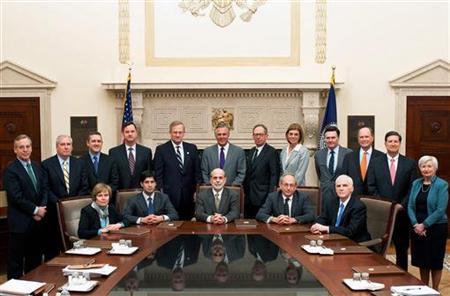
Two dangerous policies
The central thesis of this book is straightforward. During the Great Recession and the years that followed, the Federal Reserve Board adopted unprecedented policies that drowned the US economy in a tidal flood of cash. They did so in two ways, which represented the major components of the easy money policies of the 2010s. First, by dropping the ground-floor interest rate nearly to zero and keeping it there. This policy lasted so long that it even acquired an acronym: ZIRP, for Zero Interest Rate Policy. And, second, by engaging in quantitative easing (QE), which committed the Fed to purchase large quantities of bonds; the effect of this policy was to increase further—and dramatically so—the cash balances held by the nation’s major banks.
For many years, one man who served from time to time on the Federal Open Market Committee stood opposed to these policies. Thomas Hoenig (1946-), President of the Federal Reserve Bank of Kansas City, was often a lonely voice, one vote out of twelve. It’s worth quoting Leonard at length to understand why.
Why Tom Hoenig opposed these policies
“Hoenig was fighting against quantitative easing because he knew that it would create historically huge amounts of money, and this money would be delivered first to the big banks on Wall Street. He believed that this money would widen the gap between the very rich and everybody else. It would benefit a very small group of people who owned assets, and it would punish the very large group of people who lived on paychecks and tried to save money. Just as important, this tidal wave of money would encourage every entity on Wall Street to adopt riskier and riskier behavior in a world of cheap debt and heavy lending, potentially creating exactly the kind of ruinous financial bubble that had caused the Global Financial Crisis in the first place.” Many commentators misinterpreted Hoenig’s views as knee-jerk fear of inflation. But that was not a major consideration for him.
Leonard adds, “As it turned out, Hoenig was almost entirely correct in his concerns and his predictions. . . Understanding what the Fed did in November 2010 is the key to understanding the very strange economic decade that followed, when asset prices soared, the stock market boomed, and the American middle class fell further behind.”
Where did all those trillions go?
In Davos Man: How the Billionaires Devoured the World, investigative journalist Peter S. Goodman describes the outcome of these policies more dramatically: “In the decade following the financial crisis, the companies that made up the S&P 500, a broad swath of the American stock market, spent $5.3 trillion—or more than half their profits—to buy back their stock, sending their share prices higher. They spent another $3.8 trillion on handing out dividends. Over the course of those ten years, the wealth of American billionaires increased by more than 80 percent. Meanwhile, the vast majority of Americans were still waiting for the recovery.”
Surprisingly, a readable account
Few topics are as boring to the general reader as economic policy. Like contemporary specialists in every field, economists and bankers have a language all their own. When they speak or write about their work, they’re likely to confuse much more than they elucidate. The jargon is often impenetrable. But Christopher Leonard is used to it. In years of reporting on business and economics, he has gained remarkable skill at translating even the most obscure argot into lucid English. At times, the policies involved are so complex that even he (and the reader) falter. Still, nearly throughout, The Lords of Easy Money is remarkably readable. If you want to get a handle on the pivotal role the Federal Reserve Board holds in the world’s economic affairs, this book will do the trick for you.
About the author
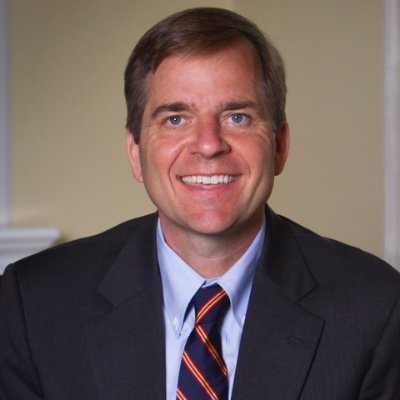
The Lords of Easy Money is Christopher Leonard‘s third book. His previous books were The Meat Racket and Kochland: The Secret History of Koch Industries and Corporate Power in America. An investigative journalist, Leonard is a graduate of the University of Missouri Journalism School. He currently serves as director of the Missouri School of Journalism Reynolds Journalism Institute.
For related reading
You might also enjoy:
- 21 good books about finance and economics
- Good books about economic inequality
- Lords of Finance: The Bankers Who Broke the World by Liaquat Ahamed (How the gold standard caused the Great Depression)
- The Lords of Creation: The History of America’s 1 Percent by Frederick Lewis Allen (Why the Great Recession happened—and the Great Depression before it)
And you can always find my most popular reviews, and the most recent ones, on the Home Page.

